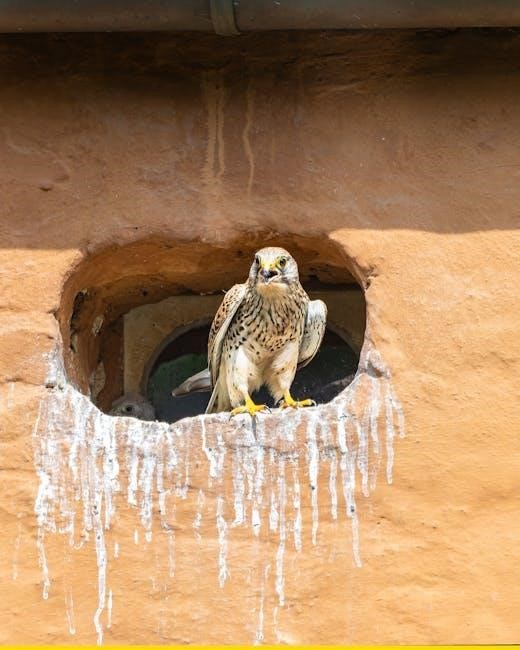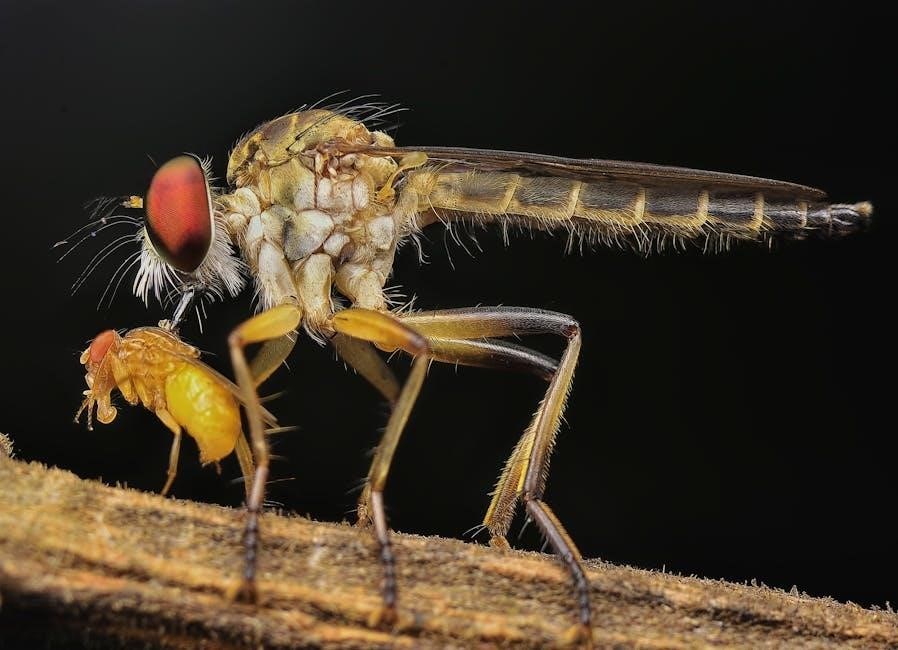This manual provides essential guidance for the Predator 212cc engine, covering safety, assembly, operation, and maintenance. Read carefully to ensure safe and optimal engine performance.
Purpose of the Manual
This manual is designed to provide comprehensive guidance for the safe and effective use of the Predator 212cc engine. It covers essential information on assembly, operation, maintenance, and troubleshooting to ensure optimal performance. The manual serves as a reference for owners and operators, offering detailed instructions to prevent accidents and prolong engine lifespan. By following the guidelines outlined, users can maximize efficiency while minimizing risks. This document is a critical resource for anyone working with the Predator 212cc engine.
Importance of Reading the Manual
Reading this manual is crucial for the safe and proper use of the Predator 212cc engine. It contains vital safety warnings, assembly instructions, and maintenance procedures to ensure optimal performance and longevity. Failure to follow the guidelines can result in engine damage or personal injury. The manual also highlights special messages, such as cautions and warnings, to draw attention to critical safety concerns. By thoroughly reviewing this document, users can operate the engine confidently and effectively. This manual serves as an essential resource for troubleshooting and maintaining the engine.
Safety Instructions
Always follow safety guidelines to prevent accidents and ensure proper engine operation. Keep the manual handy for quick reference and adhere to all warnings.
General Safety Precautions
Always wear protective gear, including gloves and safety glasses, when handling the engine. Ensure the area is well-ventilated to avoid inhaling harmful fumes. Keep loose clothing and long hair tied back to prevent entanglement. Never operate the engine near open flames or sparks, as it may cause fire hazards. Avoid overreaching or stretching while working on the engine, as this can lead to loss of balance. Keep children and pets away from the engine during operation or maintenance. Follow all safety warnings and precautions outlined in this manual to minimize risks and ensure safe operation.
Engine Safety Warnings

Adhere to all engine safety warnings to prevent accidents and ensure safe operation. Never operate the engine indoors, as it produces carbon monoxide, which can be deadly in enclosed spaces. Always ensure proper ventilation when running the engine. Avoid modifying the engine or bypassing safety features, as this can lead to serious hazards and void the warranty. Keep flammable materials away from the engine, and never touch hot engine components. Follow the manufacturer’s guidelines strictly to minimize risks and ensure reliable performance.

Operating Environment Safety
Ensure the engine operates in a safe and suitable environment. Avoid running the engine near open flames or sparks to prevent fire hazards. Use the engine on level, stable surfaces to maintain balance and prevent accidents. Keep the area clear of debris and ensure proper ventilation to avoid carbon monoxide buildup. Operate the engine in well-ventilated outdoor locations only, as indoor use can be dangerous. Always follow local regulations and safety guidelines to ensure safe and responsible engine operation.

Engine Specifications
The Predator 212cc engine is designed for high performance and durability. With a 212cc displacement, it offers reliable power for various applications, including go-karts and small equipment.
212cc Engine Overview
The Predator 212cc engine is a horizontal, single-cylinder, four-stroke gasoline engine designed for versatility and reliability. It is commonly used in go-karts, mini bikes, and small equipment, offering a balance of power and efficiency. With a displacement of 212 cubic centimeters, this engine provides ample torque and speed for recreational and light-duty applications. Its compact design and lightweight construction make it easy to install and maintain, while its durable build ensures long-lasting performance under various operating conditions.
Technical Details and Features
The Predator 212cc engine features a 4-stroke, overhead valve (OHV) design with a displacement of 212 cubic centimeters. It delivers a maximum of 6.5 horsepower at 3000 RPM and 7.5 horsepower at 3600 RPM, depending on the configuration. The engine is air-cooled for efficient heat management and is equipped with a recoil start system. It is available in both Hemi and non-Hemi versions, with the Hemi offering improved combustion efficiency. The engine weighs approximately 55 pounds, making it lightweight and suitable for go-karts, mini bikes, and other small vehicles.
Differences Between Hemi and Non-Hemi Versions
The Hemi version of the Predator 212cc engine features a hemispherical combustion chamber, enhancing combustion efficiency and allowing for higher compression ratios. This design increases power output and fuel efficiency. The Non-Hemi version uses a conventional combustion chamber, offering reliable performance at a lower cost. Both engines share the same displacement and basic architecture but differ in combustion chamber design and performance capabilities. The choice between Hemi and Non-Hemi depends on the user’s need for power versus affordability.

Installation and Assembly
This section guides you through the unpacking, inventory, and step-by-step assembly of the Predator 212 engine. Follow instructions carefully to ensure proper installation and safe operation.

Unpacking and Inventory
Begin by carefully unpacking the Predator 212 engine and verifying all components against the provided parts list. Ensure the package includes the engine, hardware bag, and owner’s manual. Inspect for damage or missing items. Write the product’s serial number in the manual for future reference. Organize the parts to avoid misplacement during assembly. If any components are missing or damaged, contact technical support immediately. Proper inventory ensures a smooth assembly process and prevents delays.
Step-by-Step Assembly Guide
Begin by reviewing the assembly instructions thoroughly. Gather all tools and components from the hardware bag. Attach the engine to a stable work surface using the provided mounting hardware. Ensure proper alignment of the intake, exhaust, and carburetor. Follow the torque specifications for all bolts and nuts. Connect the throttle and choke cables securely. Install the air filter and spark plug, ensuring they are properly seated. Double-check all connections for tightness and alignment. Refer to the parts list for clarification if needed. Complete the assembly before moving to engine operation.
Mounting the Engine
Mounting the Predator 212cc engine requires careful preparation to ensure stability and proper alignment. Choose a flat, sturdy surface and use the provided mounting hardware. Align the engine’s mounting holes with the surface brackets, ensuring the engine is level. Tighten all bolts securely, following the recommended torque specifications. Double-check the alignment to avoid vibration or imbalance. Ensure the exhaust and intake systems are clear of obstructions. Proper mounting is crucial for safe operation and optimal performance. Always refer to the torque specifications in the appendices for accuracy.
Operation and Control
This section covers starting procedures, throttle control, choke operation, and engine modes. Ensure the area is clear, follow safety guidelines, and monitor performance for optimal efficiency.
Starting the Engine

To start the Predator 212 engine, ensure the area is clear of obstructions. Set the choke to the “start” position and ensure the throttle is in the “stop” position. Check the oil and fuel levels to confirm they are adequate. Prime the engine if necessary by gently pulling the primer bulb. Pull the starter rope firmly with a steady motion until the engine ignites. Once running, gradually move the choke to the “run” position. Avoid sudden throttle changes and never operate the engine indoors to prevent carbon monoxide risks.
Throttle and Choke Control
The Predator 212 engine features a throttle and choke system designed for precise control. The choke is used to start and warm up the engine, while the throttle regulates speed. Always start with the choke in the “start” position and transition to “run” once the engine is warm. Gradually adjust the throttle to avoid sudden acceleration. Proper use of these controls ensures smooth operation, prevents engine damage, and enhances safety. Refer to the manual for detailed diagrams and instructions on their correct operation.
Engine Operating Modes
The Predator 212 engine operates in multiple modes to suit various applications. The primary modes include start, run, and To safely shut down the Predator 212 engine, follow these steps. First, disengage the throttle and allow the engine to run at idle for a few seconds. This helps cool the engine and prevents damage. Next, turn the engine switch to the “OFF” position. Ensure all components are cool before performing maintenance. Always avoid sudden shutdowns, as this can cause engine damage. Proper shutdown procedures are crucial for maintaining performance and extending the engine’s lifespan. Never shut off the engine while it is under load. Follow these steps carefully to ensure safety and prevent potential issues. Proper shutdown also helps maintain warranty validity. Regular maintenance ensures optimal performance and longevity of the Predator 212 engine. Follow the recommended schedule for oil changes, filter inspections, and cleaning procedures. Always use specified lubricants and avoid harsh chemicals. Keep the engine free from debris and ensure proper ventilation. Regular cleaning prevents corrosion and maintains efficiency. Refer to the manual for detailed cleaning instructions and maintenance intervals to keep your engine running smoothly and safely. A regular maintenance schedule is crucial for the Predator 212 engine’s performance and longevity. Perform oil changes every 20 hours of operation, using the specified oil type. Replace the air filter every 50 hours or as needed, and inspect the spark plug annually. Check and tighten all bolts and fasteners periodically to ensure stability. Clean or replace fuel filters quarterly to maintain fuel flow efficiency. Follow the recommended torque specifications for all connections. Regular lubrication of moving parts prevents wear and tear. Always refer to the manual for detailed intervals and procedures to maintain engine health and warranty validity. Proper maintenance ensures safety, efficiency, and reliable operation of the engine. Regular oil changes and proper lubrication are essential for the Predator 212 engine’s longevity. Use a high-quality 10W-30 or 10W-40 motor oil and replace the oil filter with a genuine Predator 212 filter (part #68120). Warm up the engine briefly before draining the oil to ensure it flows freely. Dispose of used oil responsibly. Lubricate moving parts like the piston and gears with a light, non-corrosive grease. Check the oil level before each use and top it off as needed. Always refer to the manual for specific torque and lubrication specifications to ensure optimal performance and prevent engine damage. Regular cleaning is crucial for maintaining the Predator 212 engine’s performance and longevity. Start by turning off the engine and allowing it to cool completely. Use compressed air to remove dirt and debris from the exterior and intake areas. For tougher spots, a soft-bristle brush can gently sweep away grime. Avoid using harsh chemicals or abrasive materials, as they may damage components. Instead, wipe surfaces with a mild detergent mixed with warm water and a soft cloth. Rinse thoroughly and dry with a clean towel to prevent rust. Regular cleaning helps prevent corrosion and ensures reliable engine operation; This section helps identify and resolve common issues with the Predator 212 engine, ensuring quick fixes and minimizing downtime for optimal performance. The Predator 212 engine may experience issues like hard starting, overheating, or low power. Check the air filter and spark plug for cleanliness and proper connection. Ensure the fuel tank is vented and fuel is fresh. If overheating occurs, inspect the cooling system for blockages. For low power, verify throttle operation and exhaust system condition. Regular oil checks can prevent engine damage. Addressing these common issues promptly ensures reliable performance and extends engine lifespan. Always refer to the manual for specific troubleshooting steps. To diagnose issues with the Predator 212 engine, start by identifying specific symptoms, such as unusual noises, loss of power, or difficulty starting. Check for error codes using diagnostic tools if available. Perform a visual inspection for signs of wear, damage, or leaks. Test components like the spark plug, fuel filter, and ignition system. Refer to the troubleshooting guide for detailed procedures and solutions. Early identification and resolution of problems can prevent further damage and ensure optimal engine performance. Always follow safety guidelines during diagnostics. This section outlines the warranty coverage for the Predator 212 engine, including duration and conditions. Improper use or lack of maintenance may void the warranty. The Predator 212 engine is covered by a limited warranty for defects in materials and workmanship. The warranty period typically lasts for two years from the date of purchase. Coverage includes repairs or replacements of defective parts when used under normal conditions. However, the warranty does not apply to damage caused by misuse, neglect, or failure to follow the manual’s instructions. Operating the engine indoors or without proper maintenance voids the warranty. Serial number registration and proof of purchase are required for warranty claims. Always refer to the official documentation for specific terms and conditions. The warranty becomes void under specific circumstances, such as improper installation, misuse, or unauthorized modifications. Operating the engine indoors, insufficient oil levels, or failure to follow maintenance schedules also void coverage. Tampering with emissions components or using non-approved parts invalidates the warranty. Damage caused by overloading, neglect, or improper storage is not covered. Always adhere to the manual’s guidelines to maintain warranty validity; For full details, refer to the official documentation provided with your Predator 212 engine. This section includes essential reference materials, such as torque specifications, detailed parts lists, engine diagrams, and a glossary of technical terms for the Predator 212 engine. This section provides detailed torque specifications for the Predator 212 engine, ensuring proper assembly and maintenance. It includes values for cylinder head bolts, crankcase bolts, and other critical components. Following these specifications is crucial for maintaining engine performance and preventing damage. Refer to the table for exact torque values and sequences to ensure accuracy during repairs or adjustments. Always use a torque wrench and consult the manual before starting any work on the engine. Proper torque ensures longevity and reliability. This section contains a comprehensive list of all components for the Predator 212 engine, along with detailed diagrams. These diagrams are labeled to help users identify each part accurately. The parts list is organized by engine section, such as cylinder head, crankcase, and carburetor, making it easy to locate specific components. Use these resources to ensure proper assembly, repairs, and maintenance. For further assistance, contact our technical support team at predator@harborfreight.com.Shutting Down the Engine

Maintenance and Cleaning
Regular Maintenance Schedule
Oil Change and Lubrication
Cleaning the Engine
Troubleshooting
Common Issues and Solutions
Diagnosing Engine Problems
Warranty Information
Warranty Coverage Details
Voiding Warranty Conditions

Appendices
Torque Specifications
Parts List and Diagrams
Glossary of Terms
This glossary explains technical terms related to the Predator 212 engine, such as Hemi (a hemispherical combustion chamber design) and torque specifications (precise tightening values for bolts). Understanding these terms ensures proper engine operation and maintenance. For additional definitions, refer to the engine manual or contact predator@harborfreight.com for support. Proper terminology use is crucial for safe and effective engine management.

Contact Information
For assistance, email predator@harborfreight.com for general inquiries or engine@harborfreight.com for engine-specific support. Using an engine indoors can be dangerous and potentially fatal.
Technical Support Contact
For technical inquiries regarding the Predator 212cc engine, contact our support team at predator@harborfreight.com. Ensure to include your engine model, serial number, and a detailed description of your issue. Our team is dedicated to providing timely assistance for troubleshooting, maintenance, and operational guidance. Additionally, refer to the manual for comprehensive instructions. Please note that using an engine indoors can be hazardous; always operate it in a well-ventilated area.



